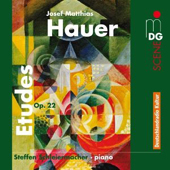
ESSENTIAL RECORDINGS

In his fascinating book titled 'The Infinite Variety of Music', Leonard Bernstein points out that the maximum number of possible combinations
using the 12 notes of the scale is 1,302,061,344. And that is playing one note at a time. If you add vertical (chords) and horizontal combinations together,
the figure is more like 127 followed by 103 zeros. Add to this all the variants of rhythm, tempo, colors and dynamics, and the possibilities start to make
your head spin. These mathematical equations help to explain why these Nine Atonal Etudes for Piano, Op. 22 by Austrian
composer Josef Matthias Hauer (1883-1959) all sound highly individual and different, even within their strict theoretical boundaries.
Josef Matthias Hauer was a twelve-tone (serial) music composer and educator. His first treatise on 12-tone composition was published
in 1919/20, three years before Arnold Schoenberg released his own theoretical writings on the technique. And even though both composers elaborated
on their systems from different angles, they strongly debated over a period of many years as to who came up with the idea first. Oddly enough, these
piano works were dedicated to Arnold Schoenberg on his fiftieth birthday.
In the booklet notes pianist Steffen Schleiermacher indicates that most of the time Hauer's music sounds tonal but never "tonical".
Both listening to and playing Hauer's etudes makes one feel that one is treading "tonal ground". And no more is that true than in the deceptively
beautiful Etude No. 5, which orbits very closely to the harmonic world of Scriabin, and actually ends on a fully "tonic" triad. Unlike Schoenberg who would
not allow any tonal chords to slip into the music's fabric, Hauer used them deliberately. I would even go so far as to say that, even though Hauer's
compositions are "music by numbers", this particular etude is so well worked out that it puts to shame many other works by composers
using standard methods.
No suggestions of tempo or dynamic markings were included by the composer for the performance of these piano works. After all, they are not etudes
meant to challenge a pianist's capabilities. They are studies on 12-tone organization and as Hauer himself explained, the power of tones and intervals. Therefore
a large amount of credit is due Steffen Schleiermacher for the variety of moods and colors he manages to filter out of these
"calculated tones", and the way he exposes the heart that feeds the brain. And also many plaudits to the people at MDG for
having the courage of conviction to release recordings of this unjustly neglected composer. They seem to be the only label to have a few CDs devoted completely
to the music of Josef Matthias Hauer. A deeply passionate composer who spent the second half of his life in ill-health, neglect and poverty. This recognition
is way overdue.
Jean-Yves Duperron - April 2012